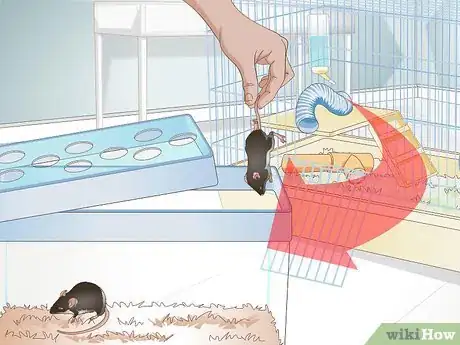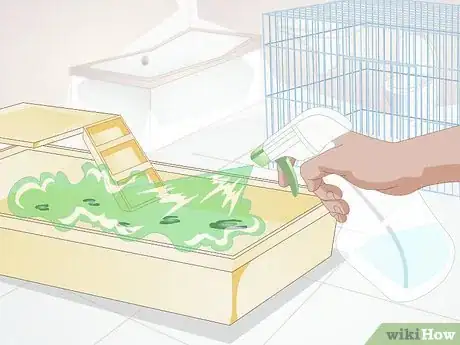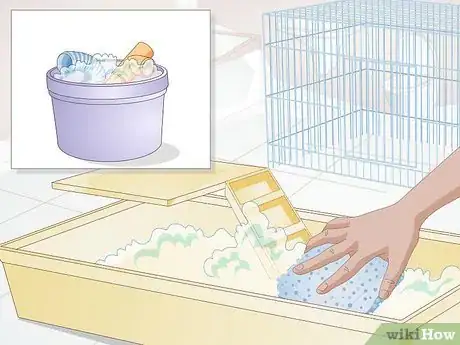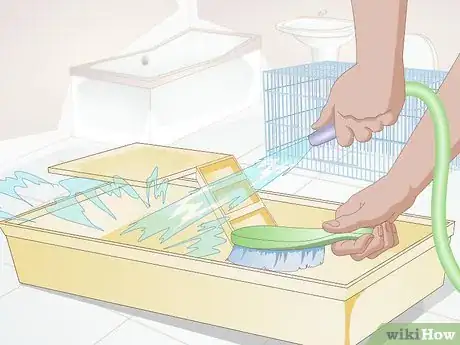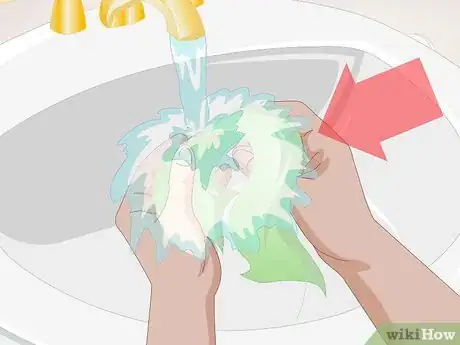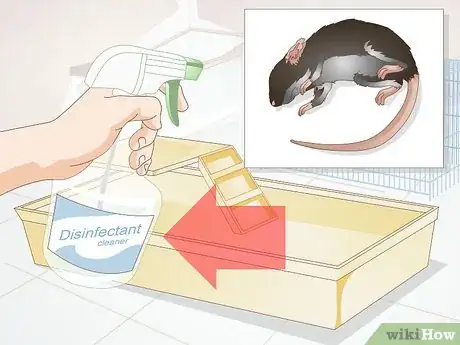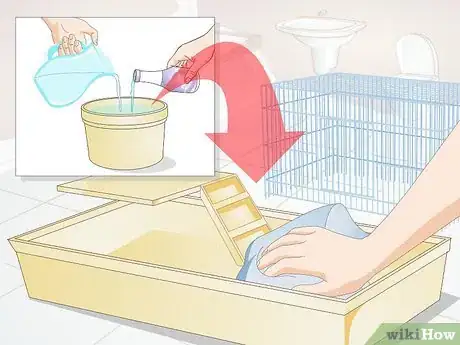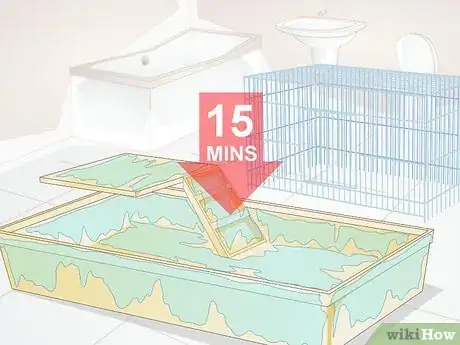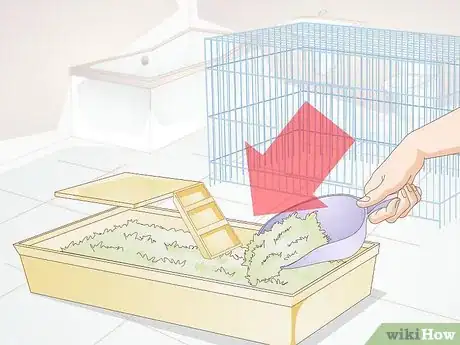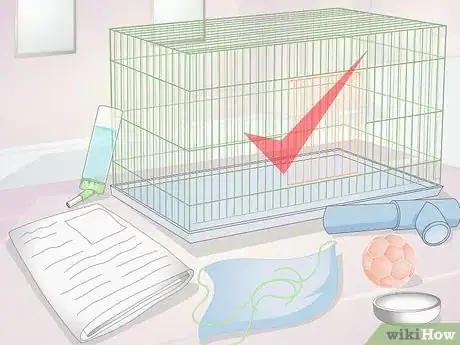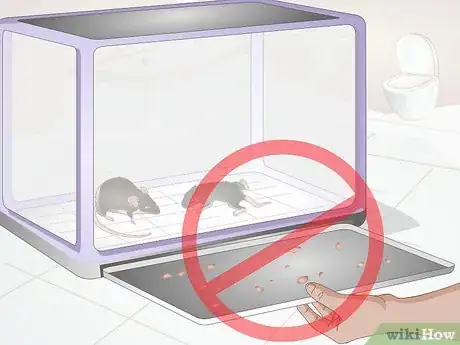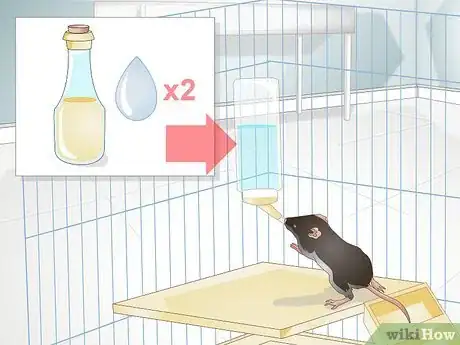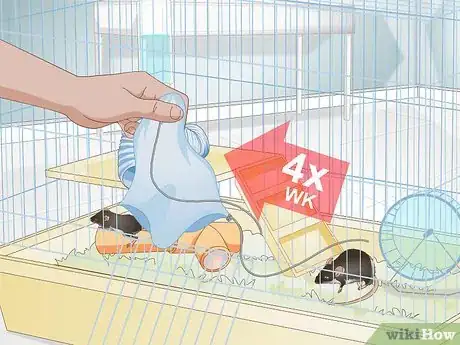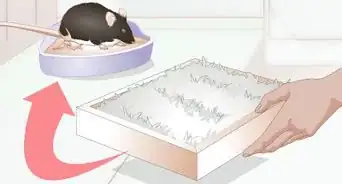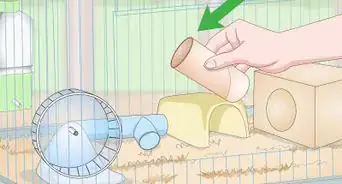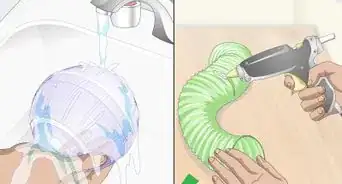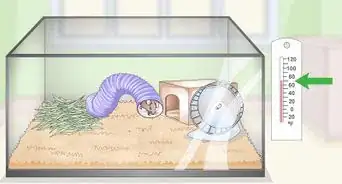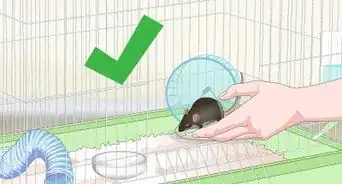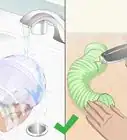This article was co-authored by Pippa Elliott, MRCVS. Dr. Elliott, BVMS, MRCVS is a veterinarian with over 30 years of experience in veterinary surgery and companion animal practice. She graduated from the University of Glasgow in 1987 with a degree in veterinary medicine and surgery. She has worked at the same animal clinic in her hometown for over 20 years.
This article has been viewed 55,567 times.
Maintaining a clean cage is important no matter what type of pet you have. For rats, however, it is even more important. Rat urine is concentrated and has a high ammonia content. Ammonia is extremely irritant to a rat's delicate lungs and can predispose them to infections such as pneumonia. In addition, damp bedding can harbor harmful bacteria or fungi.[1] Keep your rat cage clean by following a few simple guidelines.
Steps
Cleaning Out the Cage
-
1Wash your rat’s cage on a regular basis. Spot clean soiled areas daily and clean the entire cage at least once a week. If you start to notice an ammonia smell, you've likely waited too long. Set up a cleaning schedule so that ammonia never injures your rat.[2]
- Natural rat litters made from materials like hay/straw and aspen wood shavings will need changing more often.
-
2Move your rat to a temporary location. Before cleaning your rat’s cage, you should remove him. Your rat could easily get loose during cleaning if you don't secure him. You also don’t want to expose your rat to cleaning products. Remember to never pick up your rat by its tail!
- Place your rat in a temporary bin with a lid and air holes.
- Make sure you place either litter or bedding into the temporary bin to absorb waste.
- Clean and disinfect this bin after you move the rat back into his cage.
Advertisement -
3Empty the cage. Take apart your rat’s cage so you can clean it more easily. Remove all the toys, bedding, and rat litter, disposing of the litter and bedding in a trash bag. Be sure to detach the top or bottom if your cage is made to be taken apart.
-
4Spray to soften the residue. There may be soiled litter or bedding stuck in the cage. For example, litter can clump together and solidify to the sides or bottom. After the cage is empty, spray down the interior with plain water. This will soften the residue so you can wipe it out later. [3]
-
5Wash the cage and accessories with dish soap. Take a washcloth, rag, or sponge and get it wet and soapy. Regular dish soap is fine. Wipe out the interior of the cage, pausing to scrub any residue that doesn't come up right away.[4]
- Submerge all toys and accessories in soapy water. Scrub them with dish soap or degreaser if needed.
- Rinse and allow them to air dry.
- If any accessories are dishwasher safe, you can place them in the dishwasher instead of hand washing.
-
6Use a scrub brush and pressure nozzle. You may find that there is still residue in the cage even after wiping it down. If this is the case, grab a scrub brush and place a pressure nozzle on a garden hose. Scrubbing the stuck-on residue and spraying it with high-pressure water will help it come off.[5]
- A degreaser, also called a solvent cleaner, will break down grease and other tough residue. They are especially useful on metal cages.[6]
-
7Wash cloth items. If you have towels, hammocks, etc., in your rat cage, be sure to thoroughly wash and dry them. If they get soiled between cage cleaning days, wash them immediately to prevent dirtying the rest of the cage.[7]
-
8Rinse everything. After you're done washing and scrubbing out the cage, make sure you thoroughly rinse both the cage and accessories. You don’t want your rat ingesting any soap or degreaser. You should wipe out the cage with a clean cloth after rinsing it to clear away any soap residue. [8]
Disinfecting a Rat’s Cage
-
1Disinfect the cage if you have new or sick rats. You don’t have to disinfect your rat cage every single time you wash it because soapy water will remove most bacteria; however, using disinfectant is good practice and will do no harm. Disinfect it just before introducing new rats to your cage or if your rat is sick.[9]
- Rat diseases to look for include skin disorders (like fleas and mites), roundworms, parasites, and so on.
-
2Use bleach or another disinfectant. You can use pure bleach or another disinfectant (such as Lysol) to disinfect your rat cage. Mix the disinfectant with water to dilute it — 15 parts water to every one part of bleach. Then apply the disinfectant to all surfaces and cage accessories.[10]
- You may want to mix up the disinfectant solution in a spray bottle so you can easily spray down all surfaces.
- Otherwise you can saturate a cloth with the disinfectant solution and wipe everything down.
-
3Leave the disinfectant on for 15 minutes. For best results, allow the disinfectant to remain on all surfaces for about 15 minutes. This allows the bleaching agent to kill all germs. After this, rinse everything again.[11]
- Make sure to disinfect any water bottles and feeders. They are the most likely culprits for spreading diseases. [12]
- After rinsing, set out all the items so they can be air dried.
-
4Add new bedding and replace clean items. Once the cage is clean, disinfected, rinsed, and dried, you can replace everything. Of course you should add unused litter and bedding so that everything is fresh. [13]
- Spread the bedding so that it is about a quarter inch thick.
Keeping Odors Under Control
-
1Keep the cage clean. A smelly cage is one that isn't cleaned often enough. Key to good hygiene is keeping the cage clean so that odors do not develop.
-
2Clean out cages with specific styles more often. Some cages are better for rats than others. For example, avoid cages made of uncoated metal. You should also stay away from cages with a mesh floor or a pullout pan. Both styles cause odors to build up.
- Exposed metal retains odors so that it is hard to wash smells out.
- Pullout pan cages allow waste to drop down below the cage and sit there. Rats walking directly on the litter (as in other types of cages) reduces smell, so this pullout style will need to be cleaned two or three times as often.
-
3Try adding apple cider vinegar to the water. You can actually reduce the odor of rat urine by adding agents to their water and food supply. Adding two drops of apple cider vinegar to 8 ounces of water should be enough.
- You may also be able to purchase products at the pet store that do the same thing.
-
4Change the bedding where they sleep and urinate more often. If you want to reduce how often you clean the cage, focus on areas where they urinate the most. For example, rats are known to urinate where they sleep. Replace bedding where they sleep between cage cleaning days. If they have a spot they like to urinate in, change the litter here more frequently.
- Try training your rat to urinate in the same place every time. Place a small box of litter in one corner. Leave the rest of the cage bare without any litter.[14]
- Try placing small litter boxes in every corner of a rat’s cage since they naturally urinate in corners.
- Pick up feces and place them in the litter boxes to help rats see where they are supposed to defecate.
-
5Replace non-plastic accessories often. Any wood, cloth, paper, or cardboard accessories can soak up a lot of urine. Change out these things three or four times per week to keep ammonia buildup under control.
- One idea is to use a plastic igloo-style house for sleeping instead of a hammock.
Warnings
- Make sure not to use bedding with pine or cedar. It can cause damage to a rat’s respiratory system.⧼thumbs_response⧽
Things You'll Need
- Fresh bedding (pine and cedar free)
- Dish soap and water
- Clean cloth or rag
- Bleach or other disinfectant
References
- ↑ http://ratguide.com/care/environment/cage_cleaning.php
- ↑ http://www.ratfanclub.org/hygiene.html
- ↑ http://ratguide.com/care/environment/cage_cleaning.php
- ↑ http://www.ratfanclub.org/hygiene.html
- ↑ http://ratguide.com/care/environment/cage_cleaning.php
- ↑ http://www.afrma.org/howclean.htm
- ↑ http://ratguide.com/care/environment/cage_cleaning.php
- ↑ http://www.ratfanclub.org/hygiene.html
- ↑ http://www.ratfanclub.org/hygiene.html
About This Article
To clean a rat's cage, start by emptying it out and washing everything with soapy water. If there's still any residue on the cage or accessories, clean it off using a hose and a scrub brush. Then, thoroughly rinse everything, and set it all aside to air dry. Finally, once everything is dry, reassemble the cage and add new litter and bedding. Repeat the process once a week so your rat doesn't get sick. For more tips from our Veterinary co-author, like how to disinfect a rat's cage, scroll down!

